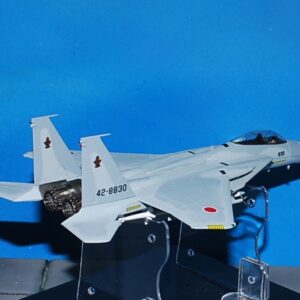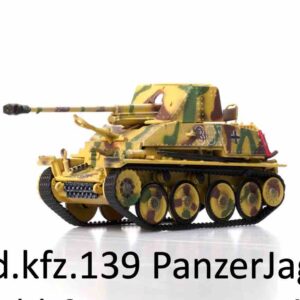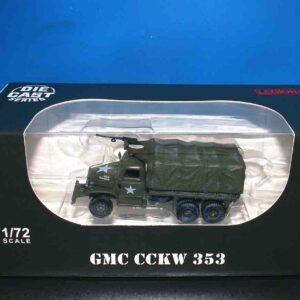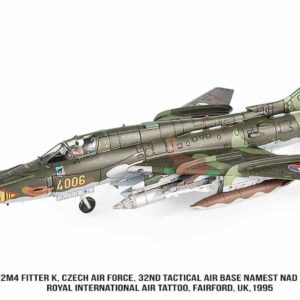DeAgostini Japan Self Defense Force – McDonnell Douglas F-4EJ Phantom II , JASDF
499 Kč
Skladem
Výrobce: DeAgostiniMěřítko: 1:100Popis
-sběratelský model letadla McDonnell Douglas F-4 Phantom II 1/100 -provedení: plastový model
McDonnell Douglas F-4 Phantom II
The McDonnell Douglas F-4 Phantom II is a tandem two-seat, twin-engine, all-weather, long-range supersonic jet interceptor and fighter-bomber originally developed for the United States Navy by McDonnell Aircraft. It first entered service in 1960 with the U.S. Navy. Proving highly adaptable, it was also adopted by the U.S. Marine Corps and the U.S. Air Force, and by the mid-1960s had become a major part of their air wings.
| Role | Interceptor, fighter-bomber |
|---|---|
| National origin | United States |
| Manufacturer | McDonnell Aircraft McDonnell Douglas |
| First flight | 27 May 1958 |
| Introduction | 30 December 1960 |
| Retired | 1992 (UK) 1996 (U.S. combat use) 2013 (Germany) 2016 (U.S. target drone) |
| Status | In limited service |
| Primary users | United States Air Force (historical) United States Navy (historical) United States Marine Corps (historical) Iranian Air Force |
| Produced | 1958–1981 |
| Number built | 5,195 |
| Unit cost |
US$2.4 million (FY1965, new build F-4E)
|
| Variants | McDonnell Douglas Phantom FG1/FGR2 |
F-4EJ
Simplified F-4E exported to and license-built in Japan.
General characteristics
- Crew: 2
- Length: 63 ft 0 in (19.2 m)
- Wingspan: 38 ft 5 in (11.7 m)
- Height: 16 ft 5 in (5 m)
- Wing area: 530 sq ft (49.2 m2)
- Aspect ratio: 2.77
- Airfoil: NACA 0006.4–64 root, NACA 0003-64 tip
- Empty weight: 30,328 lb (13,757 kg)
- Gross weight: 41,500 lb (18,824 kg)
- Max takeoff weight: 61,795 lb (28,030 kg)
- Maximum landing weight: 36,831 lb (16,706 kg)
- Fuel capacity: 1,994 US gal (1,660 imp gal; 7,550 l) internal, 3,335 US gal (2,777 imp gal; 12,620 l) with 2x 370 US gal (310 imp gal; 1,400 l) external tanks on the outer wing hardpoints and either a 600 or 610 US gal (500 or 510 imp gal; 2,300 or 2,300 l) tank for the centre-line station.
- Powerplant: 2 × General Electric J79-GE-17A after-burning turbojet engines, 11,905 lbf (52.96 kN) thrust each dry, 17,845 lbf (79.38 kN) with afterburner
Performance
- Maximum speed: 1,280 kn; 1,473 mph (2,370 km/h) at 40,000 ft (12,000 m)
- Maximum speed: Mach 2.23
- Cruise speed: 508 kn; 584 mph (940 km/h)
- Combat range: 367 nmi; 423 mi (680 km)
- Ferry range: 1,457 nmi; 1,677 mi (2,699 km)
- Service ceiling: 60,000 ft (18,000 m)
- Rate of climb: 41,300 ft/min (210 m/s)
- Lift-to-drag: 8.58
- Wing loading: 78 lb/sq ft (380 kg/m2)
- Thrust/weight: 0.86 lbf/lb (0.0084 kN/kg) at loaded weight, 0.58 lbf/lb (0.0057 kN/kg) at MTOW
- Takeoff roll: 4,490 ft (1,370 m) at 53,814 lb (24,410 kg)
- Landing roll: 3,680 ft (1,120 m) at 36,831 lb (16,706 kg)
VF-96 F-4J “Showtime 100” armed with Sidewinder and Sparrow missiles, 9 February 1972
Armament
- E-model has a 20 mm (0.787 in) M61A1 Vulcan cannon mounted internally under the nose, 640 Rounds
- Up to 18,650 lb (8,480 kg) of weapons on nine external hardpoints, including general purpose bombs, cluster bombs, TV- and laser-guided bombs, rocket pods, air-to-ground missiles, anti-ship missiles, gun pods, and nuclear weapons. Reconnaissance, targeting, electronic countermeasures and baggage pods, and external fuel tanks may also be carried.
- 4× AIM-9 Sidewinders on wing pylons, Israeli F-4 Kurnass 2000 carried Python-3, Japanese F-4EJ Kai carry AAM-3
- 4× AIM-7 Sparrow in fuselage recesses, upgraded Hellenic F-4E and German F-4F ICE carry AIM-120 AMRAAM, UK Phantoms carried Skyflash missiles
- 6× AGM-65 Maverick
- 4× AGM-62 Walleye
- 4× AGM-45 Shrike, AGM-88 HARM, AGM-78 Standard ARM
- 4× GBU-15
- 18× Mk.82, GBU-12
- 5× Mk.84, GBU-10, GBU-14
- 18× CBU-87, CBU-89, CBU-58
- Nuclear weapons, including the B28EX, B61, B43 and B57
Další informace
| Výrobce | |
|---|---|
| Měřítko | |
| Dostupnost | Skladem |









